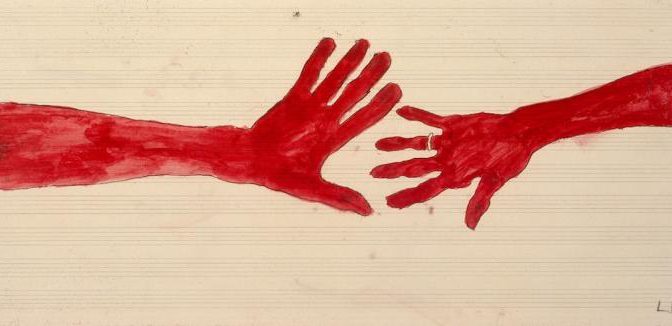By Ellie Jones (AHRC PhD researcher, Tate and English Department) and Bryony White (AHRC/ LAHP PhD researcher, English Department), co-editors of close. close is a monthly tinyletter (article sent to your inbox) exploring intimacy, intimate lives, and objects, supported by the London Arts and Humanities Partnership.
For some time, we have wanted to try and find a way to talk across our research in bodies, queer lives and intimacy. Both situated in the English Department at King’s and with desks next to one another in a small communal postgraduate research room, we have been speaking about how intimacy, its pleasures and its discontents, has long preoccupied the work of writers and artists.
In Virginia Woolf’s Mrs Dalloway, for example, intimacy is a locus of change, growth and transformation: ‘there had risen up a lovely tree in the brisk sea-salted air of their intimacy (for in some ways no one understood him, felt with him, as Clarissa did)—their exquisite intimacy’. Through intimacy, Woolf radically connects feeling to knowledge and self-understanding. However, intimacy here is also elusive. For the two former lovers, it is part of the air, atmospheric and ineffable.
The intricate dualities of intimate experience create emotional, political and subjective ambiguities that demand critical engagement. How might intimacy institute, as queer theorist Sara Ahmed might put it, ‘shared forms’—collective forms of space and exchange?
What forms might intimacy take and how might these unsettle normative approaches to (not) touching, feeling and inhabiting? How do queer modes and intimate affects challenge heteronormative, cisnormative and violently hierarchical models of feeling? How does an investigation and interrogation of intimacy open up other modes of being and doing (together), which might in fact operate beyond the human? And how might certain structures foreclose intimacy?
In close we want to look to intimacies that are shared, that challenge, that negate, and that allow other, alternative, marginalised histories to be told. We look to the unexamined relationships between partners, lovers, parents, animals and homes, and invite writers to ruminate in the messy terrain of affect and emotion.
We wanted to draw together a community of writers we admire, and whose work we find explores these topics, to release a monthly TinyLetter—a peculiarly intimate public. As such, close publishes a monthly essay, poem or story, delivered directly to our subscribers’ inboxes. These will cohere around intimacy, intimate lives, objects and bodies.

With regards to the editorial and publishing ethos of close, we aim to work across disciplines and genres in order to provide our readers with innovative and exciting new writing. With a particular focus on improving the visibility of queer, trans and non-binary voices, writers of colour, women and working class communities, we want close to serve as a platform, as writer Isabel Waidner puts it in the introduction to Liberating the Canon, to promote intersectionality against the grain of normative publishing.
We are really excited and humbled to announce that we have essays, poetry and writing from Sophie Mackintosh in May, Bridget Minamore in June, Jesse Darling in July and Helen Charman and Daisy Lafarge in August.
For our first letter, however, we wanted to begin with us, to take some time ruminating on what intimacy means: its ambivalences and its appeal. Read more.
To read close: letter #1 in full, and to subscribe to recieve future letters in your inbox, click here.
You can also follow @closetinyletter on Twitter.
Featured image: Louise Bourgeois, 10 AM Is When You Come To Me, 2006. Photo by Christopher Burke. © The Easton Foundation.
Blog posts on King’s English represent the views of the individual authors and neither those of the English Department, nor of King’s College London.
You may also like to read:

